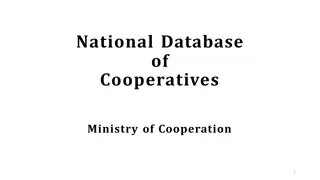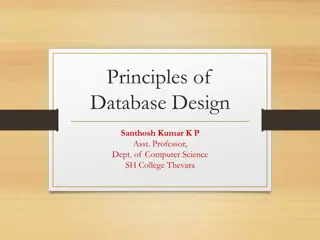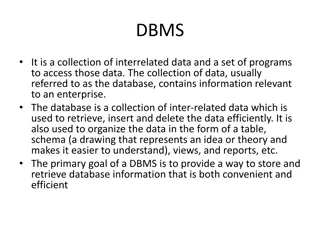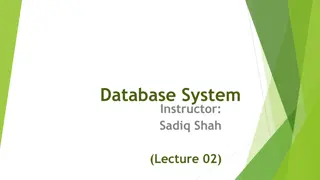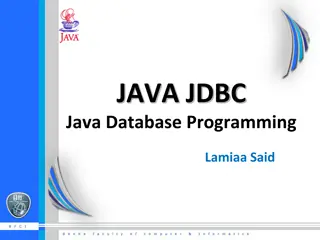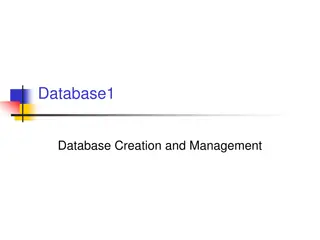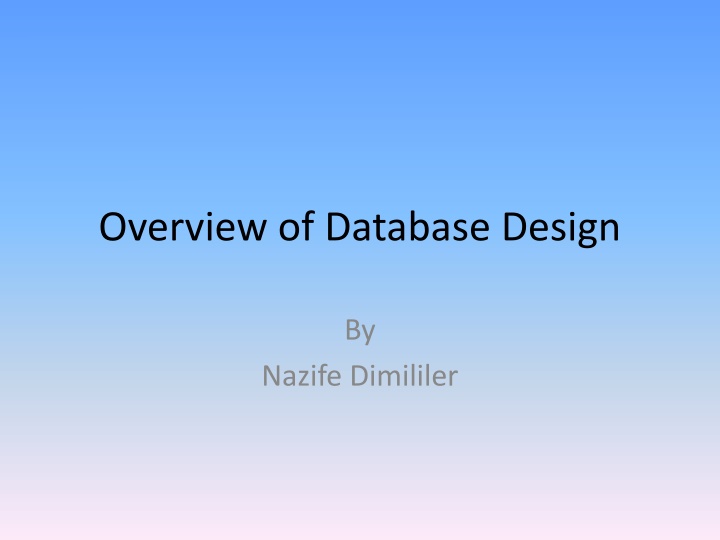
Comprehensive Guide to Database Design and Management Systems
This detailed guide covers the fundamentals of database design, the role of Database Management Systems (DBMS), advantages of a database approach, costs and risks associated with it, as well as the range of database applications. It emphasizes the importance of data integrity, consistency, access control, and disaster recovery in database management. The content outlines key concepts, benefits, and challenges of database implementation, catering to users at various levels of familiarity with database systems.
Download Presentation

Please find below an Image/Link to download the presentation.
The content on the website is provided AS IS for your information and personal use only. It may not be sold, licensed, or shared on other websites without obtaining consent from the author. If you encounter any issues during the download, it is possible that the publisher has removed the file from their server.
You are allowed to download the files provided on this website for personal or commercial use, subject to the condition that they are used lawfully. All files are the property of their respective owners.
The content on the website is provided AS IS for your information and personal use only. It may not be sold, licensed, or shared on other websites without obtaining consent from the author.
E N D
Presentation Transcript
Overview of Database Design By Nazife Dimililer
Database Management System A DBMS is a data storage and retrieval system which permits data to be stored non- redundantly while making it appear to the user as if the data is well-integrated.
Database Management System Application #1 Application #2 DBMS Database containing centralized shared data Application #3 DBMS manages data resources like an operating system manages hardware resources
Advantages of Database Approach Program-Data Independence Metadata stored in DBMS, so applications don t need to worry about data formats Data queries/updates managed by DBMS so programs don t need to process data access routines Results in: increased application development and maintenance productivity Minimal Data Redundancy Leads to increased data integrity/consistency
Advantages of Database Approach Improved Data Sharing Different users get different views of the data Enforcement of Standards All data access is done in the same way Improved Data Quality Constraints, data validation rules Better Data Accessibility/ Responsiveness Use of standard data query language (SQL) Security, Backup/Recovery, Concurrency Disaster recovery is easier
Costs and Risks of the Database Approach Up-front costs: Installation Management Cost and Complexity Conversion Costs Ongoing Costs Requires New, Specialized Personnel Need for Explicit Backup and Recovery Organizational Conflict Old habits die hard
The Range of Database Applications Personal Database standalone desktop database Workgroup Database local area network (<25 users) Department Database local area network (25-100 users) Enterprise Database wide-area network (hundreds or thousands of users)
Evolution of DB Systems Flat files - 1960s - 1980s Hierarchical 1970s - 1990s Network 1970s - 1990s Relational 1980s - present Object-oriented 1990s - present Object-relational 1990s - present Data warehousing 1980s - present Web-enabled 1990s - present
Database Design Phases Conceptual Design Model the data without any physical considerations for each user view. Logical Design Choose the data model that will be used and modify the conceptual data model to fit the data model without any other physical considerations. Validate the model using normalization and transaction requirements. Physical Design Choose the actual DBMS and implement the data model efficiently. Performance, security and reliability are key issues.
Systems Development Life Cycle Project Identification and Selection Project Initiation and Planning Analysis Logical Design Physical Design Implementation Maintenance
Systems Development Life Cycle Project Identification and Selection Purpose --preliminary understanding Deliverable request for project Project Initiation and Planning Analysis Database activity enterprise modeling Logical Design Physical Design First step in database development Specifies scope and general content Overall picture of organizational data, not specific design Entity-relationship diagram Descriptions of entity types Relationships between entities Business rules Implementation Maintenance
Systems Development Life Cycle Project Identification and Selection Purpose state business situation and solution Deliverable request for analysis Project Initiation and Planning Analysis Logical Design Physical Design Database activity conceptual data modeling Implementation Maintenance
Systems Development Life Cycle Project Identification and Selection Purpose thorough analysis Deliverable functional system specifications Project Initiation and Planning Analysis Logical Design Physical Design Database activity conceptual data modeling Implementation Maintenance
Systems Development Life Cycle Project Identification and Selection Purpose information requirements structure Deliverable detailed design specifications Project Initiation and Planning Analysis Logical Design Physical Design Database activity logical database design Implementation Maintenance
Systems Development Life Cycle Purpose develop technology specs Deliverable program/data structures, technology purchases, organization redesigns Project Identification and Selection Project Initiation and Planning Analysis Logical Design Physical Design Database activity physical database design Implementation Maintenance
Systems Development Life Cycle Purpose programming, testing, training, installation, documenting Deliverable operational programs, documentation, training materials Project Identification and Selection Project Initiation and Planning Analysis Logical Design Physical Design Database activity database implementation Implementation Maintenance
Systems Development Life Cycle Project Identification and Selection Purpose monitor, repair, enhance Deliverable periodic audits Project Initiation and Planning Analysis Logical Design Physical Design Database activity database maintenance Implementation Maintenance
Simplified Database Development Procedure Start Draw ERD Convert to Relational Schema Validate using Normalization Validate against user transactions Stop
Documentation Entity Document Entity Name Description Aliases Occurrence A short Description of entity Other names the users used to refer to this entity A common Situation where this entity can be found Name of entity Employees teaching courses Lecturer, professor Instructors work in departments Instructor
Documentation Relationship Document Relationship Type Cardinality Participation (Optionality) Entity Type Entity Type Name Of participating Entity : Entity A Name of Relationship Name of participating Entity : Entity B Cardinality from Entity A to Entity B 1:1 1:M M:1 Participation constraints on the relationship from Entity A to Entity B (Optionalities) Full (F) : Manadatory Entity (min>0) Partial (P) : Optional Entity (min=0) Instructor workFor Department M:1 P:F
Documentation Attribute Document Names of Attributes Data type and length Entity Description Constraint List of all attributes of the entity Description of each attribute Data type of each attribute. It is possible to use domain names you have described in the domain document Primary , Unique and Secondary Key. (Secondary Keys are used to search for the entity) Name of Entity Uniquely identifies a student. Student Student Id 6 fixed character Primary Key Full name of student 50 variable character Name Secondary Index Gender of student Gender 1 fixed character
Documentation Attribute Document Continued Names of Attributes Null Value? (Yes or No) Default Value Alias Derived? List of all attributes of the entity Default value for attributes Other names, the users used for the attribute Yes : Null values are allowed No: Null values are not allowed Yes: It is derived No: It is not derived Student Id No Name No Gender F Sex Yes Cumulative grade cgpa Yes Yes
Documentation Attribute Domain Document Domain Name Domain Characteristics Examples of allowed values Name of Domain for attributes Description of domain Illustrative examples 3 digit floating point between 0.00 and 4.00 Cgpa domain 3.33, 4.00 1 character string ( F or M ) Gender M, F
APPLY NORMALIZATION If you normalized your database design, you can be more confident that there will be no redundancy in the final database. There are three basic checks that most relational database designers carry out. 1NF REMOVE REPEATING GROUPS 2NF REMOVE PARTIAL DEPENDENCIES 3NF REMOVE NON-KEY DEPENDENCIES
USEFUL DESIGN PRINCIPLES 1-Faitfulness Entity sets, their attributes and relationships should reflect reality Don t attach pointless attributes. Employee Number-of-legs Relationships between attributes depend on the policy of organization. department employee works employee department works
USEFUL DESIGN PRINCIPLES 2-Avoid Redundancy id Student Advisor id name advisorname name 3- Simplicity counts Avoid introducing more elements into your design Than is absolutely necessary. kindergarten id Student highschool name
USEFUL DESIGN PRINCIPLES 4- Choosing the right relationship Adding to our design every possible relationship is not often a good idea. It can cause to redundancy. Resulting database could require more space to store redundant elements. Modifying the database could become more complex.
USEFUL DESIGN PRINCIPLES 5- Picking the right kind of element. title studioname movie Repeat studio name and address for each movie If studio doesn't have any movie, we lost the address of the movie studioaddress year studio movie filmedBy studioname studioaddress title year
USEFUL DESIGN PRINCIPLES 5- Picking the right kind of element. Example 1: Using Multiway relationship Example 1: If entity set has only one attribute and relationship is 1:N relationship. f E F E K e k K e k e K f e k K F k
Helpful pointers Transform complex attributes to entities. ServiceRecord ServiceRecord Employee ServiceDate EquipmentNo EmployeeNo Description ServiceDate EquipmentNo EmployeeName Description performedBy EmployeeId FirstName LastName Hiredate
Helpful pointers Use lookup entities(tables) for frequently used data. student student country sresident Id Name Country Id Name CountryCode code Name Employee eresident Employee Id Name Salary CountryCode Id Name Salary Country
Helpful pointers Split compound attributes customer customer customerId Name StreetAddress City Country customerId Name Address
Helpful pointers Transform weak entities to strong entities Invoice Invoice InvoiceNo InvoiceDate CustomerId InvoiceNo InvoiceDate CustomerId payments payments Installment Installment InstallmentId InvoiceNo InstallmentDate Amount InvoiceNo InstallmentDate Amount
Helpful pointers Add History Instructor id Name Instructor TitleChanges id Name Title InstructorTitle ChangeDate Title
Some helpful pointers Use consistent naming rules for all entities,relationships and attributes Choose primary keys intelligently. Primary keys should NOT change over time. Choose appropriate data types for attributes
Intelligent vs Surrogate Keys A surrogate key is an artificial or synthetic key that is used as a substitute for a natural key aka intelligent key. "Surrogate key" may also be known as "System-generated key", "Database Sequence number", "Synthetic key", "Technical key" or an "Arbitrary, unique identifier". primary keys are hard to change. Intelligent keys suffer from this problem because not only are they used as primary and foreign keys but they also have some business meaning associated with them The biggest advantage for intelligent keys is that users understand what they mean whereas surrogate keys don't make any business sense. Data Models that use surrogate keys usually have more normalization errors.
Surrogate vs. Intelligent Keys Natural keys: are more logical can sometimes can mean fewer joins help to encourage good modeling are traditional/user friendly make snooping around in the data easier Surrogate keys: are shorter are easier to join take less storage enable natural key fields to be easily changed are what Object Oriented (and object relational) databases use
Some helpful pointers : Physical Database Design Purpose - translate the logical description of data into the technical specifications for storing and retrieving data Goal - create a design for storing data that will provide adequate performance and insure database integrity, security and recoverability
Some helpful pointers : Physical Design Process Inputs Decisions Normalized relations Attribute data types Volume estimates Physical record descriptions (doesn t always match logical design) Attribute definitions Response time expectations Leads to Data security needs File organizations Backup/recovery needs Indexes and database architectures Integrity expectations Query optimization DBMS technology used
Some helpful pointers : Designing Fields Field: smallest unit of data in database Field design Choosing data type Coding, compression, encryption Controlling data integrity
Some helpful pointers : Field Data Integrity Default value - assumed value if no explicit value Range control allowable value limitations (constraints or validation rules) Null value control allowing or prohibiting empty fields Referential integrity range control (and null value allowances) for foreign-key to primary-key match- ups
Some Helpful Pointers : Denormalization Transforming normalized relations into unnormalized physical record specifications Benefits: Can improve performance (speed) be reducing number of table lookups (i.e reduce number of necessary join queries) Costs (due to data duplication) Wasted storage space Data integrity/consistency threats Common denormalization opportunities One-to-one relationship Many-to-many relationship with attributes Reference data (1:N relationship where 1-side has data not used in any other relationship)
Common Design problems Misplaced relationships Incorrect Cardinalities Missing Relationships Overuse of specialized data modeling tools (ex: Inheritance, multiway relationships) Redundant Relationships
Goals of Database Development Develop a Common Vocabulary Define the meaning of Data Ensure Data Quality Find an Efficient Implementation
Final Word Remember that the goal of the DB development is to produce a DB that provides an important resource for an organization. The DB should be designed so that it can serve the customers and other team members efficiently.

